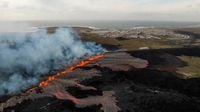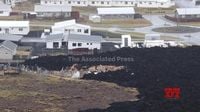For nearly a year, the small Icelandic town of Grindavik has been living under the shadow of relentless natural upheaval. Since December 2023, a staggering nine volcanic eruptions have rocked this coastal community, forcing repeated evacuations and turning daily life upside down for its residents. The story of Grindavik is one of resilience, exhaustion, and hope—a town caught between the wild beauty of Iceland's volcanic landscape and the harsh realities of living on its edge.
According to the Associated Press, the eruptions began abruptly in late 2023, sending plumes of ash and rivers of lava dangerously close to homes, roads, and the town’s modest infrastructure. Each time the earth rumbled, authorities scrambled to move people out of harm’s way. The evacuations, sometimes with little warning, became a grim routine. For many, the constant threat proved too much to bear. Most residents have packed up and left, seeking safety and stability elsewhere. Yet, a handful of determined townsfolk remain, holding out hope that life in Grindavik can someday return to normal.
"We are exhausted by the disruptions, but hope life can return to normal," one resident told the Associated Press, capturing the mood of those who have chosen to stay. Their days are marked by uncertainty—never quite sure when the next eruption will force them to leave again, or if the town will ever be truly safe.
The impact of these eruptions has been profound. Grindavik, once a bustling fishing community, has seen its population dwindle dramatically. Streets that were once lively with the comings and goings of families and fishermen now stand eerily quiet. Schools and shops have shuttered, and the hum of daily life has been replaced by the ever-present possibility of evacuation orders and the distant thunder of volcanic activity.
Repeated displacement has taken a toll not only on the physical landscape but also on the mental health of residents. The Associated Press reports that those who remain are “exhausted by disruptions,” a phrase that hardly does justice to the emotional strain of living in a state of near-constant emergency. It’s not just the fear of the volcanoes themselves, but the endless cycle of packing up, moving out, and returning to uncertainty that wears people down.
Yet, despite all this, hope persists. Some residents have refused to abandon their homes, clinging to the belief that the eruptions will subside and that Grindavik can be rebuilt. These holdouts are driven by a deep connection to the land and to each other—a sense of community that even nature’s fury cannot easily erase.
“Most people have moved away, but some have stayed,” the Associated Press notes. The reasons for staying are as varied as the people themselves. For some, it’s a matter of heritage and identity; for others, it’s about economic necessity, with livelihoods tied to the sea and the land. Whatever their motivations, those who remain are united by a stubborn determination to see their town survive.
The repeated evacuations have also highlighted the resilience of local authorities and emergency services. Each eruption brings new challenges—blocked roads, damaged infrastructure, and the need to coordinate safe passages for residents and livestock alike. Over time, the community has become practiced at responding to disaster, but that doesn’t make the experience any less harrowing.
Grindavik’s ordeal is a stark reminder of Iceland’s unique geological setting. The island nation sits atop the Mid-Atlantic Ridge, where the Eurasian and North American tectonic plates meet. This makes Iceland one of the most volcanically active places on Earth. While eruptions are a fact of life here, the frequency and intensity of the recent events in Grindavik have been exceptional.
Historically, Icelanders have learned to coexist with their volatile environment. The country’s landscape is dotted with reminders of past eruptions—lava fields, craters, and geothermal springs. For many, these features are a source of national pride and even economic opportunity, drawing tourists from around the world. But for the people of Grindavik, the romance of living near a volcano has given way to a more sobering reality.
As the months have dragged on, the question on everyone’s mind is whether Grindavik can recover. Is it possible for a town so battered by natural forces to rebuild and thrive once more? Local officials and residents alike are grappling with this uncertainty, weighing the risks of staying against the deep ties they feel to their home.
Some experts suggest that the town’s future may depend on new investments in infrastructure and disaster preparedness. Improved monitoring systems, reinforced buildings, and better evacuation plans could make it safer for residents to return. Others argue that the risks are simply too great, and that relocation may be the only viable option for many families.
Meanwhile, the story of Grindavik has captured the attention of people around the world. Images and videos from the Associated Press and other outlets show the dramatic power of the eruptions—fiery fountains of lava lighting up the night sky, ash clouds billowing over the landscape, and stoic residents watching from a distance as their town is once again threatened. These scenes have become emblematic of both the beauty and the danger of life in Iceland.
For those who have left, the decision was anything but easy. Many have relocated to other parts of the country, starting over in unfamiliar surroundings. The trauma of displacement lingers, and the sense of loss is palpable. Yet, for some, there is comfort in knowing that they have escaped the immediate danger, even as they worry about friends and family who chose to stay behind.
Looking ahead, the fate of Grindavik remains uncertain. Will the eruptions subside, allowing residents to return and rebuild? Or will the town become another casualty of Iceland’s restless geology, its homes and streets reclaimed by the lava fields? Only time will tell.
For now, the people of Grindavik continue to hope for a return to normalcy, even as they brace for whatever nature has in store next. Their story is a testament to the human spirit—a reminder that, even in the face of overwhelming odds, hope can endure.





